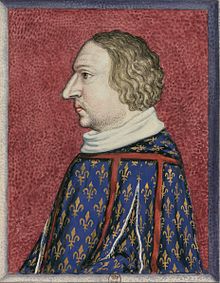You can help expand this article with text translated from the corresponding article in French. (August 2023) Click [show] for important translation instructions.
|
| Louis I | |
|---|---|
 17th-century portrait of Louis | |
| Count of Anjou | |
| Reign | 1356–1360 |
| Successor | Himself as Duke of Anjou |
| Duke of Anjou | |
| Reign | 1360–1384 |
| Successor | Louis II |
| Regent of France | |
| Regency | 1380-1382 |
| Monarch | Charles VI |
| Born | 23 July 1339 Château de Vincennes, Vincennes, France |
| Died | 20 September 1384 (aged 45) Bisceglie, Italy |
| Spouse | Marie of Blois |
| Issue | Louis II of Anjou Charles, Prince of Taranto |
| House | Valois-Anjou |
| Father | John II of France |
| Mother | Bonne of Bohemia |
Louis I, Duke of Anjou (23 July 1339 – 20 September 1384) was a French prince, the second son of John II of France and Bonne of Bohemia.[1] His career was markedly unsuccessful. Born at the Château de Vincennes, Louis was the first of the Angevin branch of the Valois royal house. His father appointed him Count of Anjou and Count of Maine in 1356, and then raised him to the title Duke of Anjou in 1360 and Duke of Touraine in 1370.
He fought in the Battle of Poitiers (1356), in which his father the king was captured by the English. In 1360, he was one of a group of hostages the French surrendered to the English in exchange for the king. He escaped from England, after which his father felt bound in honour to return to English custody, where he later died.
In 1382, as the adopted son of Joanna I of Naples, he succeeded to the counties of Provence and Forcalquier. He also inherited from her a claim to the kingdoms of Naples and Jerusalem. He was already a veteran of the Hundred Years' War against the English when he led an army into Italy to claim his Neapolitan inheritance. He died on the march and his claims and titles fell to his son and namesake, Louis II, who succeeded in ruling Naples for a time.
- ^ Keane 2016, p. 17.